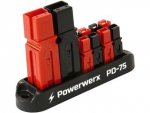prcguy
Member
Looks like you lost one of the PA transistors, which I believe are FETs in that model. If the amp was not in use and in transmit mode then a PA transistor should not be affected from a nearby lightning strike, only things in the through path back to the radio might receive a jolt.
So here’s the insides. The humorous part is the tiny little fuse in the second picture is still good to go. So whatever those parts are on the top and bottom just has a catastrophic failure that didn’t seem to affect the rest of the amp.


